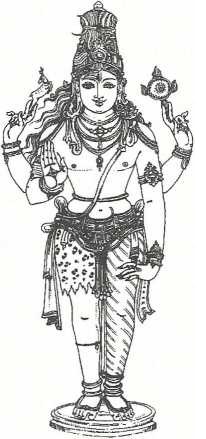Harihara
By Swami Harshananda
Harihara literally means Viṣṇu and Śiva’.
Though God is one and can be worshiped through various forms and names, this principle is often forgotten by the devotees of the various deities. This results in mutual conflicts, disturbing the social fabric and peace. Hence great saints have often made serious attempts for the reconciliation of the various sects, sometimes using ingenious means. The ‘Harihara’ and the ‘Ardha-nāriśvara’ deities seem to be such innovations.
Right Side of Harihara[edit]
Harihara, also called Haryardha-murti and Śañkaranārāyaṇa, is Hara (Śiva) on the right side and Hari (Viṣṇu) on the left side. The right half may be shown as red or white in complexion and has a half of the third eye on the forehead. The two right hands hold the trident or the mṛga (deer) and show the abhayamudrā.
Left Side of Harihara[edit]
The left half is dark in complexion, has yellow silk robes and the hands hold the śaṅkha (conch) and gadā (mace). Sometimes cakra (discus) and padma (lotus) are shown instead of the conch and the mace.
As per Vāmanapurāna[edit]
As per this purāna, Viṣṇu is said to have revealed this form to the gods who had approached him to know where Śiva was.
Harihara, A town[edit]
As per another version a demon named Guhāsura had obtained a boon from Brahmā that neither Hari nor Hara should be able to kill him. Hence Hari and Hara joined together in this form and killed him. The place where this manifestation took place is called ‘Harihara.’ It is an important town in the Chitradurga district of Karnataka and has a beautiful temple of Saṅkara-nārāyaṇa.[1] Icons of this form seem to be of great antiquity (CE 100) and belong to the Kuśāna period.
References[edit]
- ↑ It is same as Harihara.
- The Concise Encyclopedia of Hinduism, Swami Harshananda, Ram Krishna Math, Bangalore

